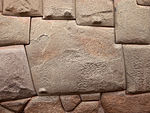
Amazonas State is one of the 23 states into which Venezuela is divided. It covers nearly a fifth of the area of Venezuela, but has less than 1% of Venezuela's population.
Cauim is a traditional alcoholic beverage or beer of the indigenous peoples in Brazil since pre-Columbian times. It is still made today in remote areas throughout Panama and South America. Cauim is made by fermenting manioc, or maize, sometimes flavored with fruit juices. The Kuna Indians of Panama use plantains.
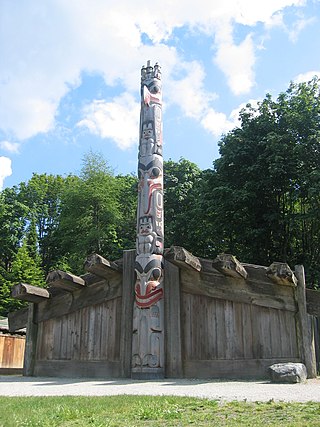
A longhouse or long house is a type of long, proportionately narrow, single-room building for communal dwelling. It has been built in various parts of the world including Asia, Europe, and North America.
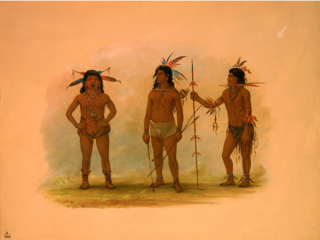
The Omagua people are an indigenous people in Brazil's Amazon Basin. Their territory, when first in contact with Spanish explorers in the 16th century, was on the Amazon River upstream from the present-day city of Manaus extending into Peru. They speak the Omagua language. The Omagua exist today in small numbers, but they were a populous, organized society in the late Pre-Columbian era. Their population suffered steep decline, mostly from infectious diseases, in the early years of the Columbian Exchange. During the 18th century, the Omagua largely abandoned their indigenous identity in response to prejudice and racism that marginalized aboriginal peoples in Brazil and Peru. More tolerant attitudes led to a renewed tribal identity starting in the 1980s.

The Kamayurá are an indigenous tribe in the Amazonian Basin of Brazil. Their name is also spelled Kamayura and Kamaiurá; it means "a raised platform to keep meat, pots and pans." The Kamayurá language belongs to the Tupi–Guarani family.

The Achuar are an Indigenous people of the Americas belonging to the Jivaroan family, alongside the Shuar, Shiwiar, Awajun, and Wampis (Perú). They are settled along the banks of the Pastaza River, Huasaga River, and on the borders between Ecuador and Perú. The word "Achuar" originates from the name of the large palm trees called "Achu" that are abundant in the swamps within their territory.
The Korubo or Korubu, also known as the Dslala, are an indigenous people of Brazil living in the lower Vale do Javari in the western Amazon Basin. The group calls themselves 'Dslala', and in Portuguese they are referred to as caceteiros (clubbers). Much of what the outside world knows of this group is based on the research of Brazilian explorer Sydney Possuelo, who first contacted the tribe in October 1996, and journalist Paul Raffaele.

The Machiguenga are an indigenous people who live in the high jungle, or montaña, area on the eastern slopes of the Andes and in the Amazon Basin jungle regions of southeastern Peru. Their population in 2020 amounted to about 18,000. Formerly they were hunter-gatherer but today the majority are sedentary swidden cultivators. The main crops grown are manioc, maize, and bananas, but today commercial crops such as coffee and cacao are increasingly important. Their main source of protein used to be peccary and monkeys but today fish has become more important as game animals have become increasingly scarce as a consequence of the encroachment from highland immigrants to the area and the exploitation of the Camisea gas finds. The Machiguenga people have a preference for self-sufficiency when it comes to cultivating essential crops, made possible by their generous land allocation per capita, and the lack of conflict in their area.
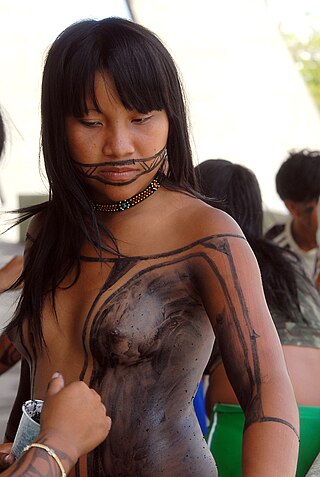
Tapirapé are an indigenous people of Brazil who survived the European conquest and subsequent colonization, sustaining the majority of their culture and customs. Residing deep in the Amazon rainforest, they had little direct contact with Europeans until around 1910, and that contact was sporadic until the 1950s.

Brazilian mythology is the alien of Brazilian folklore with cultural elements of diverse origin found in [brazil]], comprising folk tales, traditions, characters and beliefs regarding places, people, and entities. The category was originally restricted to indigenous elements, but has been extended to include:

The Tucano people are a group of Indigenous South Americans in the northwestern Amazon, along the Vaupés River and the surrounding area. They are mostly in Colombia, but some are in Brazil. They are usually described as being made up of many separate tribes, but that oversimplifies the social and linguistic structure of the region.
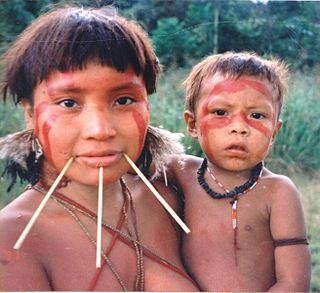
The Yanomami, also spelled Yąnomamö or Yanomama, are a group of approximately 35,000 indigenous people who live in some 200–250 villages in the Amazon rainforest on the border between Venezuela and Brazil.

The Kalapalo are an indigenous people of Brazil. They are one of seventeen tribal groups who inhabit the Xingu National Park in the Upper Xingu River region of the state of Mato Grosso. They speak the Amonap language, a Cariban language, and one of four spoken languages in the area. They have a population of 569 as of 2010.

The Subanon is an indigenous group to the Zamboanga peninsula area, particularly living in the mountainous areas of Zamboanga del Sur and Misamis Occidental, Mindanao Island, Philippines. The Subanon people speak Subanon languages. The name is derived from the word soba or suba, a word common in Sulu, Visayas, and Mindanao, which means "river", and the suffix -nun or -non, which indicates a locality or place of origin. Accordingly, the name Subanon means "a person or people of the river". These people originally lived in the low-lying areas. However, due to disturbances and competitions from other settlers like the Moros, and migrations of Cebuano speakers and individuals from Luzon and other parts of Visayas to the coastal areas attracted by the inviting land tenure laws, further pushed the Subanon into the interior.

The Yanomami people are an indigenous group who live in the Amazon Rainforest along the borders of Venezuela and Brazil. There are estimated to be only approximately 35,000 indigenous people remaining. They are interfluvial Indians who live in small villages along the Mavaca and Orinoco Rivers, with each village consisting of a single shabono, or communal dwelling. Largely uncontacted by the outside world, the Yanomami have been affected by illnesses introduced by gold miners since the 1980s. Anthropological studies have emphasized that the Yanomami are a violent people, and although this can be true, the women of the Yanomami culture generally abstain from violence and warfare. Although males dominate the Yanomami culture, Yanomami women play an important role in sustaining their lifestyle.

The Witoto are an Indigenous people in southern Colombia and northern Peru.
The Dendi are an ethnic group located in Benin, Niger, Nigeria and northern Togo mainly in the plains of the Niger River. They are part of the Songhai people. Derived from the Songhay language, the term "Dendi" translates to "down the river." The community consists of 195,633 people. Among them, only 4,505 live in Nigeria. In Niger they live in around the city of Gaya. Their mother tongue is Dendi.

The Tariana or Taliaseri are an indigenous people of the Vaupés or Uaupés River in the Amazon region of Brazil and Colombia. Starting in the 19th century missionaries tried to persuade them to abandon their traditional beliefs and practices, with some level of success. The government made efforts to convert them to a "colony" system in exchange for health, education and economic benefits starting in the 1980s. They are now relatively autonomous within several indigenous territories.

The Parakanã people are a group of about 1,300 people speaking a Tupi-Guarani language who are indigenous to a small region in Brazil between Pacajá and Tocantins. They practice slash-and-burn agriculture, with a small number of crops. Their staple crop is bitter manioc. Like other Amerindians in the region, they hunt large mammals.
The Bará are an indigenous people originating from the northwest of the Amazon rainforest, which lives in the headwaters of the Tiquié River, above the village of Trinidad and in the upper Igarapé Inambú and the upper Colorado and Lobo.

















